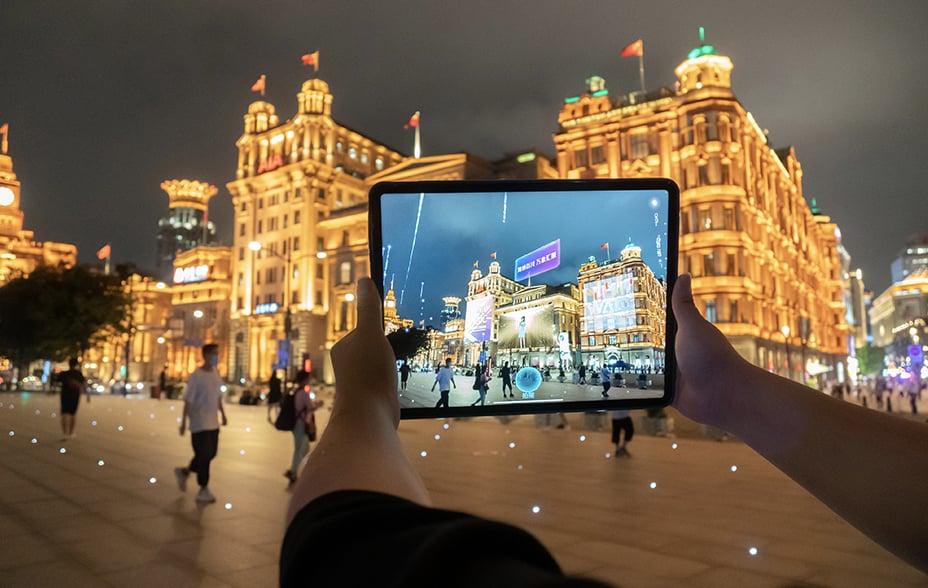Matthew Ball on investing in the metaverse
Claire Shaw – Portfolio Director
Key Points
- Matthew Ball is a venture capitalist and ex-Amazon executive who has written a book about the metaverse
- He predicts a future in which unlimited numbers of people will be able to mingle in real-time in virtual 3D worlds
- He suggests gaming companies and other start-ups will vie with the ‘tech giants’ to develop and profit from this metaverse

This is a transcript of Claire’s interview with Mathew Ball, author of The Metaverse: And How It Will Revolutionize Everything. You can read a shorter article based on the conversation here.
The ‘metaverse’ is the latest buzzword. But people often refer to the term without agreeing on what it means. You start out in your book by providing a definition. Can you summarise what you propose?
The correct frame is a quasi-successor state to the internet we know today.
A good comparison here is mobile/cloud. It’s fair to say we’re in the mobile/cloud era, in contrast to the PC and fixed-line version of the world from the 1990s and early 2000s, because we can easily observe that:
- we typically use different devices and software
- our behaviours are different
- the companies which lead are different
Yet we still use PCs, the Internet Protocol Suite1 is essentially unchanged, and almost all of the distance travelled by a packet is on fixed-line infrastructure. In this vein, we should think of the metaverse as an iterative build on today’s computing and networking platforms, which doesn’t replace them.
Let’s then talk about how it differs.
The internet is an internetworking protocol suite that spans:
- 200+ countries
- 1,000+ domain registrars
- 40,000+ networks
- 4 million+ apps
- 100 million+ servers
- 2 billion+ websites
- 6 billion+ people
- 25 billion+ devices
Each can consistently, coherently and comprehensively share information, transact, locate and understand one another.
However, this suite was built for 2D information, not 3D data. It is also not real-time. We ‘load’ a webpage not connect to one.
In addition, we experience it separately. Our inputs are not synchronised against the entire internet, which is also why when I send a file it exists on my PC, my cloud email server, the recipient’s email server, and the recipient’s device.
Modifications to any of these ‘copies’ standards separately. So, we can think of the metaverse as a ‘synchronous, real-time and 3D internet’.
This, in turn, enables a network of 3D simulations and data, which most then interpret as producing a parallel plane of existence for us all.
Jensen Huang, chief executive of NVIDIA – one of our holdings – has predicted that the metaverse’s economy will be larger than that of the physical world. How big do you think the scale of the opportunity could be?
Ultimately, this is a question of allocation.
The UN-endorsed estimate for the ‘digital economy’ is roughly $20tn, or 20 per cent of global GDP. But there’s no consensus figure because there’s no consensus methodology.
If you buy my book on Amazon, is that ‘digital revenue’? It’s bought through an ecommerce platform and on a digital device with digital payment processing. But it’s a physical book that was made through physical labours and shipped physically. How does the allocation change, though, if you learned about the book through social media? Or if it was an ebook?
Furthermore, we wouldn’t say that agriculture, energy, or education are digital businesses. Yet they are still digitally powered. Incremental farm yields, for example, rely extensively on digital technologies. However, we don’t allocate ‘digital’ portions to their revenues – we just sum their digital expenses.
What I believe Huang means is that, in addition to producing many new jobs and new value, much of the real world will depend on or run through the metaverse. This is consistent with his Earth 2.0 project and what I believe to be an essential part of the metaverse, which is making the physical world legible to software.
We often forget that the world’s greatest development platform is not the Web or iOS, but the world itself. But thus far, it is barely online, highly asynchronous in data relay and decision-making, and rarely run as an integrated ecosystem versus a collection of independent decisions.

Can you tell me about the most impressive metaverse-like experience you’ve had and why it made a lasting impression?
Microsoft Flight Simulator (MSFS) is extraordinary.
It is the most realistic and expansive consumer-grade virtual simulation in history. Its map is over 500,000,000 sq km— just like the ‘real’ planet earth — and includes two trillion uniquely rendered trees (not two trillion copy-and-pasted trees or two trillion trees made up of a few dozen varieties), 1.5 billion buildings, and nearly every road, mountain, city and airport across the world.
Everything looks like the ‘real thing’ because the landscape is based on high-quality scans and images of the ‘real thing’. This virtual world is nearly 2.5 petabytes large, or 2.5 million gigabytes. And it’s not static, either. This world reproduces much of the real world’s weather, flight traffic and architectural changes over time.
MSFS needs no enhancements to be impressive. But when you play the game using a high-end ($3,000+) VR headset, it’s impossible to come away from the experience without feeling we are on the cusp of something transformative.
You suggest several gaming companies are poised to be leading forces in the metaverse, potentially displacing Apple and Google, who dominated the mobile era.
Specifically, you mention Epic Games and Roblox – both of which Scottish Mortgage has invested in – as well as Pokémon Go developer Niantic, which we have exposure to via our stake in Brandtech Group. How might gaming companies like these disrupt the ‘big tech’ status quo?
These companies have many unique advantages which span decades. For example, they’ve more experience than most tech giants when it comes to fighting the limitations of the Internet Protocol Suite and even the speed of light.
They’re experts in creating virtual worlds we actually want to be in and have greater insight into motivational design – games are the only entertainment category based on learning through failure – than many social giants.
I don’t expect Apple or Google to be displaced anytime soon. But certainly, virtual world platforms such as Unreal, Unity, LightShip, Roblox, Omniverse et al stand to intermediate these platforms from developers and users.
Do you think it’s inevitable that a small number of players will dominate the metaverse, or is there scope for power to be less centralised this time around?
We often misrepresent the control of Big Tech. Altogether, the ‘big five’ collect less than 10 per cent of digital revenues, which is large, yes, but they’re also among the 10 largest companies globally. And much of that is simply Amazon’s ecommerce revenue – selling physical goods.
But GAFAM [Google, Apple, Facebook, Amazon, Microsoft] does have a disproportionate influence on the internet, its business models, technical standards, conventions, etc.
It is likely that a similar outcome happens with the metaverse – a handful of vertically and horizontally integrated software and hardware giants amass the substantial share of users, data, revenue, devices, etc and exert even greater influence.
However, this is separate from whether the metaverse will be less centralised than the internet we know today. This is quite possible, though failing significant regulatory action, it seems unlikely at the moment.
We should also keep in mind that there are many centralising functions beyond pure tech architecture, such as habit, brand and intellectual property.
The web was very open, and yet we still concentrated our time on platforms such as Google and Facebook, neither of which owned telecom companies used to access the internet, nor the devices we used to access it.

There are some big personalities involved, not least Meta’s Mark Zuckerberg and Epic’s Tim Sweeney. How do their visions of the metaverse differ? And specifically, how seriously should we take Sweeney’s warning that “if one company gains control, they will be more powerful than any government”?
I would argue that most big tech execs have broad alignment. However, they nevertheless view the opportunity of the metaverse in a way that naturally reflects their companies’ advantages (this may be a conscious or unconscious focus).
For example, Zuckerberg strongly emphasises avatars and VR. It’s probably not a coincidence that Meta operates the largest identity platform and VR business globally. Unity is focused on digital twins and real-time 3D for everything.
I think Sweeney is being a little hyperbolic (though note the 2nd Circuit Court of the United States has found his views to be “sincerely held”). However, it’s easy to overlook the fact that:
- no one controls or owns or charges for the internet
- the internet was not designed to sell a widget, collect a byte of data or present an ad
- the internet was designed for decentralised collaboration
The metaverse is being built for or at least around controls and for profit. Given the significance of the internet today and the potential value of the metaverse in the decades to come, I think Sweeney’s right to be concerned.
In your book, you coin ‘Sweeney’s Law’ in reference to his belief that device-based computing will advance at a faster pace than reliable cloud-based alternatives. There are many sceptics about the metaverse based on the quality of experience that today’s headsets, smartphones and other devices provide. But to what extent do they underestimate the improvements to come over the next decade?
Wearables are brutally tough. They are not necessary for the metaverse, but we often imagine them as necessary to expanding its reach – who accesses the metaverse, how often, for what, etc.
Just as multitouch displays – or indeed touchscreens or even screens – are not needed for the mobile internet. Yet we consider these things instrumental to mobile’s proliferation and importance.
A good way to consider this challenge is to review the most powerful rendering device the average person might own today: a video game console.
A PlayStation 5 weighs nearly 10lbs and is the size of a shoebox. This cannot work for a wearable. And note what the PlayStation doesn’t need, such as a display (you use your TV) or battery (it connects to the grid) or microphone (you use a headset) or environmental sensors.
You also use a PlayStation in ideal circumstances (eg a dark room) rather than highly variable ones.
Solving for all of this while having adequate battery life and power and pricing – there are just so many points of optimisation and yet too few attributes which can be traded down.
I know many who believe that unless we solve for at-scale quantum computing and/or achieve unprecedented battery life advances, XR will not get near smartphone replacement or even frequent usage for the average person.
At the same time, I’m often asked the question: “When is the metaverse here?”
The right question is when is what here, for whom and how.
In several instances, we don’t need a wearable to be fully worn, or at least worn on the face. In military applications, for example, a larger battery and processor can be worn on a backpack, thereby keeping the headset lightweight and focused.
Johns Hopkins University is already performing live patient surgery using XR devices, with most of the equipment stored under the table and accessed via cable. No mobility is needed, nor mobile network chips.
Beyond gaming, what other industries do you think are of most interest to investors seeking to benefit from metaverse-related disruption and why?
One of the best ways to understand the metaverse is around the idea that it makes the real world legible to software, in real time, and down to atomic physics (eg simulation of light, mass, etc).
This is why we see industrial simulations, or networks of them, as such a focal area among metaverse technology companies and investors.
The world’s greatest development platform isn’t iOS, Android or the web. It’s the world itself. And yet the world remains mostly offline, disconnected and asynchronous in decision-making.
The metaverse will bring to the ‘real world’ what the internet has brought to local networks and independent terminals.

One of the key takeaways from your book is the power Apple has and its potential ability to frustrate other metaverse-related companies. Can you explain why?
Beyond compelling branding and market-making industrial design, Apple’s strength has historically come from its rich vertical integration of hardware and operating system. This bundle, most notably with iPhone/iOS, but also iPod and iPod OS, Mac and MacOS, was and remains extraordinary. It doubtlessly accelerated several markets.
Over time, and as the digital ecosystem has developed, this bundle has also grown.
The Apple bundle is now hardware and operating system and first-party software and third-party software distribution and payments and identity and browser engines and APIs [application programming interface], etc.
The scope and depth of this bundle, matched with Apple’s mobile market share (66 per cent of US smartphones, 90 per cent of teens, 75 per cent of US mobile app revenue and 66 per cent globally, all growing) and closed mindset, provides the company with incredible hard, soft and even accidental power. This includes the economics of given markets, the business models a developer can and cannot deploy, the technologies these companies can and cannot use.
I think it can be fairly argued Apple uses this power to stifle competitive threats – as the most valuable (non-state operated) company in the world, generating more cash than any other in history, with control of the most successful product ever, it’s unlikely they want a change to the status quo. Especially one which shifts the platform to virtual networks rather than the device.
Specific examples here include Apple’s de facto prohibition on cloud game streaming, NFTs [non-fungible tokens] and mining, sideloading, competing app stores, as well as gatekeeping NFC [near-field communication] tap-and-pay, banning third-party browsers (Chrome on iOS is just a reskinned Safari with Google logins) and so on.
What one thing do you think most investors have wrong about the metaverse?
The metaverse is not VR, nor does it require it. The same goes for crypto/NFTs/blockchains.
Most of the value generated by the metaverse will not be in consumer-facing leisure applications (and to that end, it’s not a giant game).
The appropriate timeline to observe the development of the metaverse is decades. Some (arguably most) of those decades are behind us, but many sit in front.
What impact do you hope your book will have?
I’ve been very fortunate so far. It has become a national bestseller in the United States, United Kingdom, Canada, and China. There are more than a dozen foreign language editions out now, with a dozen more to come. It received great reviews from financial press, engineering and science trades and general interest.
I’ve heard from a number of governments and regulators. Many competing CEOs, such as those of Epic and Unity, Microsoft and Sony, and Facebook, have praised it, which means a lot because my goal was not to endorse a specific vision of the metaverse over any others nor to exclude or promote a given technology. The breadth of support suggests success in this goal, as these companies have natural disagreements and preferences when it comes to the concept and how it’s understood (or what it requires).
But the impact I aspire to and which motivated the book is separate from commercial sales, praise and interest.
I began writing about the theme in 2018 because I believed this 30-year-old term and the nearly century-old idea was not just becoming a practical opportunity but, in fact, unfolding around us. And that it would be a multi-trillion dollar, multi-decade transformation which would ultimately reach every person and business.
How the metaverse develops – under which standards, for which purposes, under which leadership and philosophies, and how it’s controlled – is so deeply important. And yet almost no information on it was widely available.
My goal with the book was to share more widely everything I’ve learned over the past five years – from private research labs, executives, founders and technologists – to help ensure we have not just a technically realised metaverse but one we actually want.
1 The internet protocol suite is sometimes referred to as TCP/IP. In simple terms, it is the rules and procedures governing how computer systems connect to and communicate with the internet. That includes how data is broken up into packets, addressed, transmitted and routed and then reassembled at its destination. This gives the internet its robustness, ensuring that even if parts of the network go down, messages and other communications still reach their recipients as efficiently as possible.
The Metaverse: And How It Will Revolutionize Everything is published by Liveright (Hardback: £22)
About the author - Claire Shaw
Portfolio Director
Claire Shaw is a portfolio director and plays a prominent role in servicing Scottish Mortgage’s UK shareholder base. Before joining in 2019, she spent over a decade as a fund manager with a focus on managing European equity portfolios for a global client base. With a background in analysing companies and communicating investment ideas, Claire is also responsible for creating engaging content that makes the Scottish Mortgage portfolio accessible to all its shareholders. Beyond that, she works closely with the managers, meeting with portfolio companies and conducting in-depth portfolio discussions with shareholders.
Regulatory Information
This content was produced and approved at the time stated and may not have been updated subsequently. It represents views held at the time of production and may not reflect current thinking. Read our Legal and regulatory information for further details.
A Key Information Document is available by visiting our Documents page. Any images used in this content are for illustrative purposes only.
This content does not constitute, and is not subject to the protections afforded to, independent research. Baillie Gifford and its staff may have dealt in the investments concerned. The views expressed are not statements of fact and should not be considered as advice or a recommendation to buy, sell or hold a particular investment.
Baillie Gifford & Co and Baillie Gifford & Co Limited are authorised and regulated by the Financial Conduct Authority (FCA). The investment trusts managed by Baillie Gifford & Co Limited are listed on the London Stock Exchange and are not authorised or regulated by the FCA.
Baillie Gifford Asia (Hong Kong) Limited 柏基亞洲(香港)有限公司 (BGA) holds a Type 1 licence from the Securities and Futures Commission of Hong Kong to market and distribute Baillie Gifford’s range of collective investment schemes and closed-ended funds such as investment trusts to professional investors in Hong Kong.
Baillie Gifford Asia (Singapore) Private Limited (BGAS) is regulated by the Monetary Authority of Singapore as a holder of a capital markets services licence to conduct fund management activities for institutional investors and accredited investors in Singapore. BGA and BGAS are wholly owned subsidiaries of Baillie Gifford Overseas Limited, which is wholly owned by Baillie Gifford & Co.
Europe
Scottish Mortgage Investment Trust PLC (the “Company”) is an alternative investment fund for the purpose of Directive 2011/61/EU (the “AIFM Directive”). Baillie Gifford & Co Limited is the alternative investment fund manager (“AIFM”) of the Company and has been authorised for marketing to Professional Investors in this jurisdiction.
This content is made available by Baillie Gifford Investment Management (Europe) Limited (“BGE”), which has been engaged by the AIFM to carry out promotional activities relating to the Company. BGE is authorised by the Central Bank of Ireland as an AIFM under the AIFM Regulations and as a UCITS management company under the UCITS Regulation. BGE also has regulatory permissions to perform promotional, advisory and Individual Portfolio Management activities. BGE has passported its authorisations under the mechanisms set out in the AIFM Directive.
Belgium
The Company has not been and will not be registered with the Belgian Financial Services and Markets Authority (Autoriteit voor Financiële Diensten en Markten / Autorité des services et marchés financiers) (the FSMA) as a public foreign alternative collective investment scheme under Article 259 of the Belgian Law of 19 April 2014 on alternative collective investment institutions and their managers (the Law of 19 April 2014). The shares in the Company will be marketed in Belgium to professional investors within the meaning the Law of 19 April 2014 only. Any offering material relating to the offering has not been, and will not be, approved by the FSMA pursuant to the Belgian laws and regulations applicable to the public offering of securities. Accordingly, this offering as well as any documents and materials relating to the offering may not be advertised, offered or distributed in any other way, directly or indirectly, to any other person located and/or resident in Belgium other than to professional investors within the meaning the Law of 19 April 2014 and in circumstances which do not constitute an offer to the public pursuant to the Law of 19 April 2014. The shares offered by the Company shall not, whether directly or indirectly, be marketed, offered, sold, transferred or delivered in Belgium to any individual or legal entity other than to professional investors within the meaning the Law of 19 April 2014 or than to investors having a minimum investment of at least EUR 250,000 per investor.
Germany
The Trust has not offered or placed and will not offer or place or sell, directly or indirectly, units/shares to retail investors or semi-professional investors in Germany, i.e. investors which do not qualify as professional investors as defined in sec. 1 (19) no. 32 German Investment Code (Kapitalanlagegesetzbuch – KAGB) and has not distributed and will not distribute or cause to be distributed to such retail or semi-professional investor in Germany, this document or any other offering material relating to the units/shares of the Trust and that such offers, placements, sales and distributions have been and will be made in Germany only to professional investors within the meaning of sec. 1 (19) no. 32 German Investment Code (Kapitalanlagegesetzbuch – KAGB).
Luxembourg
Units/shares/interests of the Trust may only be offered or sold in the Grand Duchy of Luxembourg (Luxembourg) to professional investors within the meaning of Luxembourg act by the act of 12 July 2013 on alternative investment fund managers (the AIFM Act). This document does not constitute an offer, an invitation or a solicitation for any investment or subscription for the units/shares/interests of the Trust by retail investors in Luxembourg. Any person who is in possession of this document is hereby notified that no action has or will be taken that would allow a direct or indirect offering or placement of the units/shares/interests of the Trust to retail investors in Luxembourg.
Switzerland
The Trust has not been approved by the Swiss Financial Market Supervisory Authority (“FINMA”) for offering to non-qualified investors pursuant to Art. 120 para. 1 of the Swiss Federal Act on Collective Investment Schemes of 23 June 2006, as amended (“CISA”). Accordingly, the interests in the Trust may only be offered or advertised, and this document may only be made available, in Switzerland to qualified investors within the meaning of CISA. Investors in the Trust do not benefit from the specific investor protection provided by CISA and the supervision by the FINMA in connection with the approval for offering.
Singapore
This content has not been registered as a prospectus with the Monetary Authority of Singapore. Accordingly, this content and any other content or material in connection with the offer or sale, or invitation for subscription or purchase, of the Trust may not be circulated or distributed, nor may be offered or sold, or be made the subject of an invitation for subscription or purchase, whether directly or indirectly, to persons in Singapore other than (i) to an institutional investor (as defined in Section 4A of the Securities and Futures Act 2001, as modified or amended from time to time (SFA)) pursuant to Section 274 of the SFA, (ii) to a relevant person (as defined in Section 275(2) of the SFA) pursuant to Section 275(1), or any person pursuant to Section 275(1A), and in accordance with the conditions specified in Section 275 of the SFA, or (iii) otherwise pursuant to, and in accordance with the conditions of, any other applicable provision of the SFA.
Where the Trust is subscribed or purchased under Section 275 by a relevant person which is:
(a) a corporation (which is not an accredited investor (as defined in Section 4A of the SFA)) the sole business of which is to hold investments and the entire share capital of which is owned by one or more individuals, each of whom is an accredited investor; or
(b) a trust (where the trustee is not an accredited investor) whose sole purpose is to hold investments and each beneficiary of the trust is an individual who is an accredited investor, securities or securities-based derivatives contracts (each term as defined in Section 2(1) of the SFA) of that corporation or the beneficiaries’ rights and interest (howsoever described) in that trust shall not be transferred within six months after that corporation or that trust has acquired the securities pursuant to an offer made under Section 275 except:
(1) to an institutional investor or to a relevant person or to any person arising from an offer referred to in Section 275(1A) or Section 276(4)(c)(ii) of the SFA,
(2) where no consideration is or will be given for the transfer;
(3) where the transfer is by operation of law; or
(4) pursuant to Section 276(7) of the SFA or Regulation 37A of the Securities and Futures (Offers of Investments) (Securities and Securities-based Derivatives Contracts) Regulations 2018.







